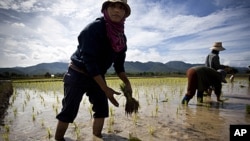Thailand is the world’s number one rice exporter and this year lost thousands of hectares of rice fields to historically high floodwaters that swept across the country. The damage has raised concerns about the affect on global rice prices and supply. But rice market analysts say a record harvest, global surplus, and a second crop should prevent any dramatic disruptions.
Thailand exports up to ten million tons of rice per year, one-third of the total global market.
But devastating floodwaters this year rolled over Burma, Cambodia, Laos, Thailand and Vietnam, killing hundreds of people and damaging wide swaths of farmland.
Thailand took the worst hit.
A quarter of the country was covered in water, much of it farms and rice paddies.
Samarendu Mohanty is chief economist at the International Rice Research Institute in the Philippines. He estimates up to seven million tons of Thailand’s rice crop was destroyed.
"They were expecting a record crop, around 25 million metric tons. So, that's a large crop and we're talking about one-fourth of the crop is damaged," noted Samarendu. "At the same time, I would like to say that if you take account of what's happening in other parts of the world and the global stocks level we have, we're still in a fairly comfortable situation.”
Samarendu says global rice stocks are at least 20 million tons higher than 2008, when some countries limited exports and rice prices quickly doubled over concerns of inadequate rice supplies.
Rice market analysts say the floods could create some temporary volatility in prices. But they say sharp cost increases are unlikely because of new producers entering the market.
In September, India lifted a ban on exports of non-basmati rice.
Those added exports and record harvests across other countries in Asia are expected to more than compensate for lost crops in Southeast Asia and prevent any dramatic jumps in price.
Concepcion Calpe is a senior economist with the United Nations Food and Agriculture Organization in Rome. “And this is mainly due to very very good crops in the major producing countries, which are mainly China, India, Bangladesh and Vietnam. The only major producing countries that may incur a loss are Indonesia because it also had some bad problems. But, until recently, the government was predicting a bumper crop also there,” stated Calpe.
Calpe says that before the floods, Thailand had an estimated five to six million tons of rice stock. And like all of East Asia, it will be able to plant a second crop once flood waters recede. “We do not believe that the floods will have more than a temporary impact. We see more [of] the damage coming from the logistics, not being able to move the supplies, rather than from a lack of supplies itself,” Calpe said.
New government price policies in Thailand are also expected to reduce its 2012 rice exports.
Prime Minister Yingluck Shinawatra promised to buy rice from farmers at above market rates in order to boost rural incomes.
Under the plan, authorities are expected to pay as much as 50 percent more for rice. While increasing domestic supplies by enticing producers with higher prices, the scheme is also expected to make Thai rice less competitive on global markets.
The scheme could contribute to Thailand losing its status as the world’s number one rice exporter as other suppliers such as India and Vietnam move in on Thai export markets.
Analyst Samarendu says higher prices for Thai rice may be a good thing for poorer rice producers such as Burma, also known as Myanmar.
“So, it might encourage Myanmar or Cambodia to emerge as exporters because of high prices. So, I think that’s not actually bad for long-term global food security considering that we need more multiple suppliers to stabilize this market,” Samarendu said.
Burma, as a British colony in the 1930s, was the world’s largest rice exporter. But civil strife, military rule, and economic mismanagement devastated production and it never recovered its lost standing.
Thai Floods Damage Rice Fields, Small Impact on Global Market Predicted
- Daniel Schearf
- VOA




